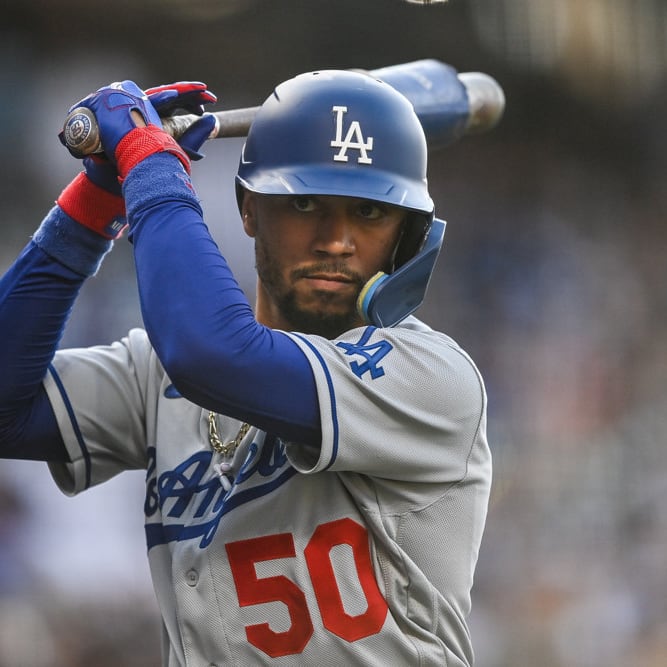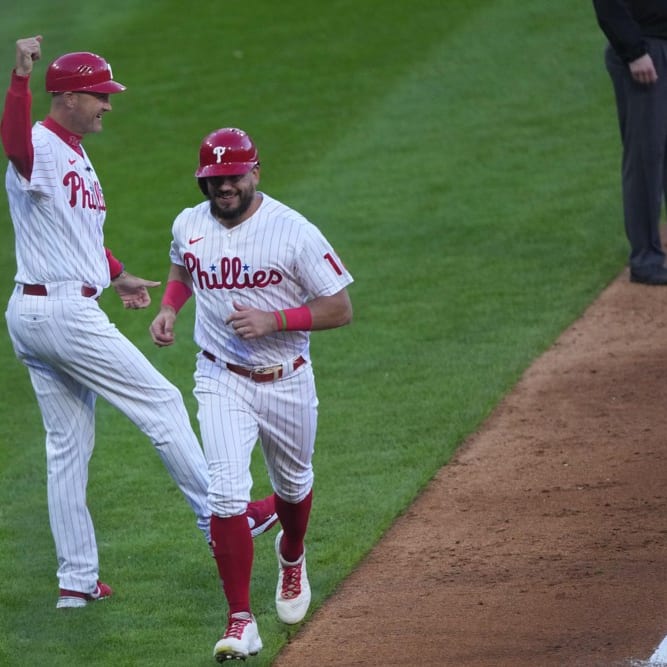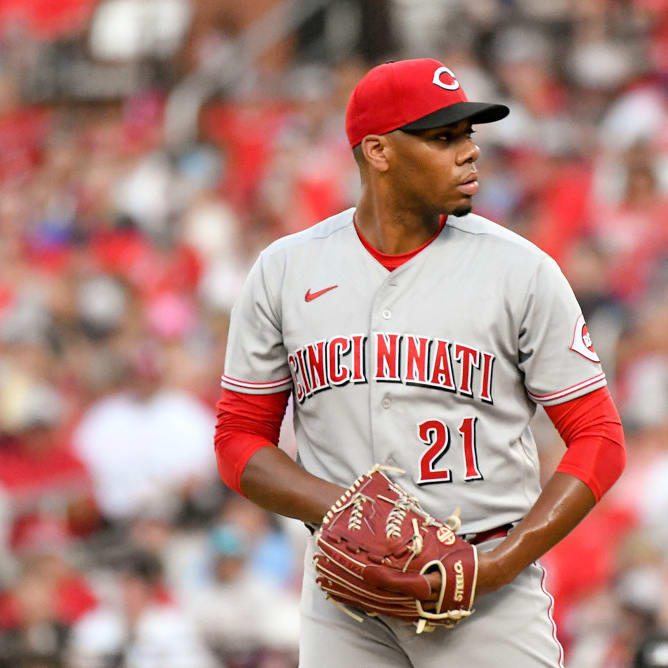This article is part of our Baseball Draft Kit series.
No problem, easy. Let me give you my foolproof 13-point plan to winning the National Fantasy Baseball Championship's Main Event in these next two thousand words and if you follow my plan EXACTLY then you are a LOCK to win the big prize.
Right. There obviously is no secret way to win the NFBC Main Event (and if I had such a plan, I wouldn't give it away here). But I am happy to share a bit of my annual process that could lead to you winning an overall title and a nice big check.
This could also be titled, "Why I Still Hate Luis Castillo".
Last winter, Castillo was among the sexiest players in fantasy. People were certain he was the next big thing. Words like "Pedro" were being used when describing his upside. It was all a bit absurd, and I proudly said so on radio and social media – fade Castillo hard at his price.
As someone who has discussed Middle East politics, religion and all manner of politics on TV and radio, let me assure you no single take I have made got the reaction that dissing Castillo elicited. People were livid.
I calmly explained to people it had nothing to do with his talent, it had everything to do with his cost (his ADP was 80th overall last year in the NFBC Main Event) and the likelihood of him returning a profit at
No problem, easy. Let me give you my foolproof 13-point plan to winning the National Fantasy Baseball Championship's Main Event in these next two thousand words and if you follow my plan EXACTLY then you are a LOCK to win the big prize.
Right. There obviously is no secret way to win the NFBC Main Event (and if I had such a plan, I wouldn't give it away here). But I am happy to share a bit of my annual process that could lead to you winning an overall title and a nice big check.
This could also be titled, "Why I Still Hate Luis Castillo".
Last winter, Castillo was among the sexiest players in fantasy. People were certain he was the next big thing. Words like "Pedro" were being used when describing his upside. It was all a bit absurd, and I proudly said so on radio and social media – fade Castillo hard at his price.
As someone who has discussed Middle East politics, religion and all manner of politics on TV and radio, let me assure you no single take I have made got the reaction that dissing Castillo elicited. People were livid.
I calmly explained to people it had nothing to do with his talent, it had everything to do with his cost (his ADP was 80th overall last year in the NFBC Main Event) and the likelihood of him returning a profit at said cost. That I turned out to be right is nice, but more importantly, the process I went through last winter was sound.
"2018 is done Rob, how does that help me for 2019?"
Well, it doesn't, but let's look at Castillo for 2019 and decide if I still hate him.
As of when I'm writing this, his ADP is 121st overall in the NFBC's way-too-early ADP. Let's pretend his ADP ends up right there.
The first thing I like to do is take that draft spot (121st) and convert it into standard 15-team, $260 per team roto auction dollars. We all understand the language of dollar values and it makes the analysis I like to do about profits and losses meaningful.
I've developed a formula for converting draft spots into auction dollars over the years that is far too wonky to share here. I would never claim that there is deep science behind my formula and that it is the only right way to do the conversion. The key thing you NEED if you are converting draft picks to dollars is for the total dollars to add up, or else they're gibberish. In a 15-team league drafting 23 players, that means the total dollars should be pretty close to $3,900 ($260 multiplied by 15) and the last player taken needs to be worth $1.
I'll give you two cheat ways to create your own dollar conversion methods. One decent way: go to Rotowire.com and take the end-of-season valuations for the size of league you're looking at (15-team mixed in this case) and see what the "pick" you're interested in was worth last year – whatever the 121st ranked player earned, that's roughly what the pick is worth. There will be some wonkiness at the top of the valuation using this method. The No. 1 player in fantasy obviously doesn't earn the same amount each year, so valuing the top picks this way doesn't really work. For most picks it works fine though. An even better way to do it is to take results over multiple years and average them.
A second cheat: here is a very rough round-by-round dollar chart that can help guide you. This is for 15-team mixed. Different league sizes will have very different distributions.
| Round | Dollar Range |
| 1 | $44 - $29 |
| 2 | $29 - $24 |
| 3 | $24 - $22 |
| 4 | $21 - $19 |
| 5 | $19 - $18 |
| 6 | $18 - $16 |
| 7 | $16 - $15 |
| 8 | $15 - $14 |
| 9 | $14 - $12 |
| 10 | $12 - $11 |
| 11 | $11 - $10 |
| 12 | $10 - $9 |
| 13 | $9 - $8 |
| 14 | $8 |
| 15 | $8 - $7 |
| 16 | $7 - $6 |
| 17 | $6 - $5 |
| 18 | $5 |
| 19 | $5 - $4 |
| 20 | $4 - $3 |
Back to Castillo. My formula tells me that the 121st draft pick is worth $14.
So if I'm taking Castillo (or any other player there), that's what I want him to earn. Actually, I want him to earn more than $14. See, if your $260 worth of draft picks returns $260 worth of value at the end of the season, you will have a mediocre team. You certainly won't win the Main Event.
You need to get about $320 or more in value onto your team by the end of the season to do well in the NFBC. Again, that's by the end of the season. Some of that excess value will come from free agent pickups and roster management. Sitting pitchers when they pitch in Colorado, for example, can "boost" their end-of-season value to your team.
Staying focused on Castillo, let's say for that 121st pick we need to get $14 for it to make sense. Castillo has of course never earned $14 before. Last year I have him earning $7 in 15-team mixed leagues.
I often have a rule that I wont pay a price for a player in the first 10 rounds that they've never earned before but let's throw that rule aside. Just because he hasn't earned $14 before doesn't mean he won't in 2019.
So let's go to the projections. Steamer has Castillo projected for a 3.98 ERA, 1.25 WHIP and 172 strikeouts in 173 innings. When I put that through my valuation formulas that gives me a $10 season. If you're following the math, you know that's a $4 loss on the 121st pick – needless to say, I'm not taking a projected $4 loss on my eighth or ninth pick.
But I can already hear the Castillo fans: "STEAMER IS WRONG! 173 innings? He'll throw 200 innings this year, guaranteed! And he isn't a 4.00 ERA pitcher – didn't you see him in the second half last year? He's way better than that."
Maybe the Castillo fans are right, which is why I don't stop at any one projection system.
What if Castillo is as good as Steamer thinks, but throws 200 innings instead of 173? When I rerun the numbers at 200 innings (giving him the extra strikeouts and an extra win), he becomes a $12 pitcher. That's better, but it's not the answer because he's still a loser.
What if he's better in 2019 than Steamer thinks he is? In the second half, he had a 2.44 ERA, 3.61 FIP, 3.17 xFIP and a very impressive 21.0 K-BB%. To earn $14, he needs to do what German Marquez, Jameson Taillon or James Paxton did last season, roughly. Even if you think the Steamer projections are too harsh, that's a tall order.
So my next step is to dig deeper into the pitcher. Specifically, I look at his pitch mix. Anyone who's watched Castillo pitch knows he has an elite changeup. Of pitchers who threw 200 or more changeups last season, he had the second-best swinging-strike rate in the game.
The problem is he only throws the changeup 26 percent of the time and doesn't really have another elite pitch. The four-seam fastball that he throws 35 percent of the time is a bit of a problem. His whiff rate with that pitch is better than only 56 percent of pitchers (i.e. his fastball is barely above average) and the ISO his fastball gave up is in the 12th percentile.
So when I'm trying to decide what the odds are that Steamer is wrong and that Castillo will take a step forward and earn $14-plus, that concerns me. Maybe other people look at the fastball and tell themselves a different story, that it improved as a pitch as the season went on or that he'll throw it less often in 2019 – do your own analysis.
My point is, that's the depth I go into on Castillo. But of course, he doesn't live in a bubble (unless he does live in a bubble – which may explain why his fastball got killed last year). I do the same depth of analysis on every other player to decide who I like more than Castillo as a player with that 121st pick. While I haven't done enough work yet to provide that name for 2019, I can almost guarantee I will have players who I have projected for $18 or even $20 who will routinely be available in the eighth round, which means, for the second year in a row, I won't be drafting Castillo.
That's a long way of saying, I do a lot of work on the player pool each winter.
"So, don't draft Luis Castillo at his current cost. That's all you've got for me, Rob?" Obviously I think there is value in the process I went through for Castillo (and yes, I really do that for almost 500 players each winter), but I'll give you a bit more.
One of the annual debates in the NFBC is how early to take starting pitching. The NFBC pushes starting pitching up aggressively – certainly more so than leagues like LABR and Tout Wars.
There are already people talking about starting their 2019 drafts by drafting pitchers in the first two rounds or three in the first five or six rounds. This would have been considered utter madness not too many years ago and now is being hyped as a savvy approach.
So how aggressive should you be on starting pitchers this year?
Let me throw some truisms out before diving into this dilemma:
1) There is no one right way to build a pitching staff in the NFBC (or any other league).
2) We all know that workhorse starting pitchers who throw 200-plus innings are becoming an endangered species – I'm not going to repeat the stats here that you've doubtlessly seen before.
3) Who you draft is way more important than when you draft them.
4) You can't win the Main Event without strong pitching and hitting.
5) Having a balanced team in the NFBC is very important because you can't trade your surplus the way you can in other leagues.
So where does that leave us?
First, you should do a thorough review (like I did for Castillo) of the pitching pool. Your pitching strategy should be driven by the player pool, not the other way around. In other words, if you don't see any pitchers you like in Rounds 3-7, you better make sure you have a strategy to take pitchers in the first two rounds, or an awful lot of targets in Rounds 8-12.
But like with the Castillo analysis, I think it's helpful to think in auction dollar terms, even for an NFBC snake draft.
In most seasons, when you convert NFBC ADP to auction dollars, the NFBC spends about 37 percent of its "dollars" on pitching. Like I said, the NFBC spends more on pitching than most leagues, where the pitching split is usually around 33-35 percent.
While there is something to be said about zigging when everyone else is zagging, let's assume you want to be roughly in line with your league's behavior, so you want to spend about 37 percent of your $260 in draft picks on pitching – that works out to $96 (you can do the same exercise I'm about to do at a different pitcher/hitter split by tweaking the numbers accordingly).
Let's say (hypothetically) you have the 13th pick. And let's say you are absolutely convinced that this year going pitcher/pitcher in the first two rounds is the way to go. So you pound starters with pick 13 and pick 18.
You are set! DeGrom and Sale! What a rotation you have! "What should I buy first with that $150,000?" you ask yourself as you get ready for your next pick. Except you know that to win the overall you need a balanced team. Too many owners decide they can find balance by gut and feel. I want to be a bit more precise.
If you are going to spend 37 percent on pitching and you use picks 13 (a $30 pick by my math) and 18 (a $29 one) on pitching, you've already spent $59 of your $96 pitching budget. If you're sticking with that budget, you only have $37 in picks left before you skew your spending towards pitching and risk the balance that is so important in the NFBC.
You don't have any closers yet (yeah, balance isn't only between hitters and pitchers, it's also across categories). For the next four rounds in this hypothetical draft, you pound hitting but then in the seventh round, closers are flying off the board, so with pick 103 you take your first closer before you miss out on the run. That's a $15 pick. You're down to $22.
In the 11th round, things are getting really bleak in the closer market, so you dip your toe in once more before everyone with the role is gone. That's a $10 pick. You're down to $12 for your last five pitching spots.
Your favorite pitching sleeper is still on the board in the 13th round and you need a third starter to compete in strikeouts – except that's a $9 pick so you now have $3 for your last four pitchers, which of course means you are over budget.
In an auction that would mean you can't draft that sleeper starter, in a straight draft the "budget" is fiction. But it's useful fiction.
My point here is not to argue for or against any one approach. My point is, do the work before your draft to figure out what different approaches to pitching will end up looking like.
Any fantasy draft is a game of trade-offs. If you take a pitcher in the first round, you don't get to take a hitter. If you take a closer early, you are passing on a hitter or a starting pitcher.
While there is something to be said about taking what the room gives you, I think you should be very deliberate about the implications of your decisions. In an auction, a team that spends over $100 on pitching may not have gone in with that as a plan, but they are (almost) always aware of what they've done by the end of the auction. In straight drafts I'm not sure how many teams really understand how they've split their picks between pitching and hitting, other than vague notions of "I got my two aces" or "I got an elite starter and the top closer." You will be well served by being a bit more precise than that.
I will spend the winter playing with different hitter/pitcher splits as I have a better feel for the player pool. Then at the draft table I will have a number of different scenarios sketched out, depending on what the room gives me.
This is a long way of saying, if you want to win the NFBC Main Event Overall, it's a lot of work. That's less satisfying than being spoon-fed a foolproof 13-point plan to win $150,000 but it's the truth. I can also tell you that winning the overall is well worth it. Good luck.
This article appears in the 2019 RotoWire Fantasy Baseball Guide. You can order a copy here.










